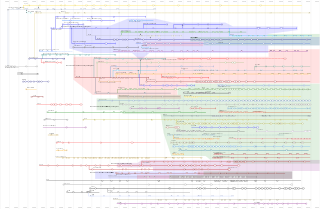Active Server Pages (ASP) is Microsoft's first server-side scripting language and engine for dynamic web pages.

Internet Explorer is a retired series of graphical web browsers developed by Microsoft that were used in the Windows line of operating systems. While IE has been discontinued on most Windows editions, it remains supported on certain editions of Windows, such as Windows 10 LTSB/LTSC. Starting in 1995, it was first released as part of the add-on package Plus! for Windows 95 that year. Later versions were available as free downloads or in-service packs and included in the original equipment manufacturer (OEM) service releases of Windows 95 and later versions of Windows. Microsoft spent over US$100 million per year on Internet Explorer in the late 1990s, with over 1,000 people involved in the project by 1999. New feature development for the browser was discontinued in 2016 and ended support on June 15, 2022 for Windows 10 Semi-Annual Channel (SAC), in favor of its successor, Microsoft Edge.

Adobe Flash is a multimedia software platform used for production of animations, rich internet applications, desktop applications, mobile apps, mobile games, and embedded web browser video players.

Netscape Navigator is a discontinued proprietary web browser, and the original browser of the Netscape line, from versions 1 to 4.08, and 9.x. It was the flagship product of the Netscape Communications Corp and was the dominant web browser in terms of usage share in the 1990s, but by around 2003 its user base had all but disappeared. This was partly because the Netscape Corporation did not sustain Netscape Navigator's technical innovation in the late 1990s.
In computing, cross-platform software is computer software that is designed to work in several computing platforms. Some cross-platform software requires a separate build for each platform, but some can be directly run on any platform without special preparation, being written in an interpreted language or compiled to portable bytecode for which the interpreters or run-time packages are common or standard components of all supported platforms.
JScript is Microsoft's legacy dialect of the ECMAScript standard that is used in Microsoft's Internet Explorer web browser.

Avant Browser is a discontinued freeware web browser from a Chinese programmer named Anderson Che with the browser engines Trident, Gecko, and Webkit the user can switch between. It runs on Windows 2000 and above, including Windows 8, Windows 8.1 and Windows 10. Internet Explorer versions 6 through 11 are supported.

A browser war is a competition for dominance in the usage share of web browsers. The "first browser war," (1995–2001) pitted Microsoft's Internet Explorer against Netscape's Navigator. Browser wars continued with the decline of Internet Explorer's market share and the popularity of other browsers including Firefox, Google Chrome, Safari, Microsoft Edge and Opera.
This is a comparison of both historical and current web browsers based on developer, engine, platform(s), releases, license, and cost.
Trident is a proprietary browser engine for the Microsoft Windows version of Internet Explorer, developed by Microsoft.

Internet Explorer for Mac was a proprietary web browser developed by Microsoft for the Macintosh platform to browse web pages. Initial versions were developed from the same code base as Internet Explorer for Windows. Later versions diverged, particularly with the release of version 5, which included the cutting-edge, fault-tolerant and highly standards-compliant Tasman layout engine.

Windows Internet Explorer 7 (IE7) is a web browser for Windows. It was released by Microsoft on October 18, 2006, as the seventh version of Internet Explorer and the successor to Internet Explorer 6. Internet Explorer 7 is part of a long line of versions of Internet Explorer and was the first major update to the browser since 2001. It was the default browser in Windows Vista and Windows Server 2008, as well as Windows Embedded POSReady 2009, and can replace Internet Explorer 6 on Windows XP and Windows Server 2003, but unlike version 6, this version does not support Windows 2000, Windows ME, or earlier versions of Windows. It also does not support Windows 7, Windows Server 2008 R2 or later Windows Versions.
Adobe Flash Player is computer software for viewing multimedia content, executing rich Internet applications, and streaming audio and video content created on the Adobe Flash platform. It can run from a web browser as a browser plug-in or independently on supported devices. Originally created by FutureWave under the name FutureSplash Player, it was renamed to Macromedia Flash Player after Macromedia acquired FutureWave in 1996. It was then developed and distributed by Adobe Systems as Flash Player after Adobe acquired Macromedia in 2005. It is currently developed and distributed by Zhongcheng for users in China, and by Harman International for enterprise users outside of China, in collaboration with Adobe.

Microsoft developed 11 versions of Internet Explorer for Windows from 1995 to 2013. Microsoft also developed Internet Explorer for Mac, Internet Explorer for UNIX, and Internet Explorer Mobile respectively for Apple Macintosh, Unix, and mobile devices; the first two are discontinued but the latter runs on Windows CE, Windows Mobile, and Windows Phone.
Nokia Browser for Symbian was the default web browser for the S60 and Symbian mobile phone platform. The browser is based on a port of Apple Inc.'s open-source WebCore and JavaScriptCore frameworks which form the WebKit rendering engine that Apple uses in its Safari Web browser.

Sleipnir is a tabbed web browser developed by Fenrir Inc. The browser's main features are customization and tab functions. It supports HTML5 and multiple layout engines.

Google Chrome is a cross-platform web browser developed by Google. It was first released in 2008 for Microsoft Windows, built with free software components from Apple WebKit and Mozilla Firefox. Versions were later released for Linux, macOS, iOS, and also for Android, where it is the default browser. The browser is also the main component of ChromeOS, where it serves as the platform for web applications.

Chromium is a free and open-source web browser project, primarily developed and maintained by Google. This codebase provides the vast majority of code for the Google Chrome browser, which is proprietary software with additional features.

WebGL is a JavaScript API for rendering interactive 2D and 3D graphics within any compatible web browser without the use of plug-ins. WebGL is fully integrated with other web standards, allowing GPU-accelerated usage of physics, image processing, and effects in the HTML canvas. WebGL elements can be mixed with other HTML elements and composited with other parts of the page or page background.

Internet Explorer 10 (IE10) is the tenth, and by now, discontinued, version of the Internet Explorer web browser and the successor to Internet Explorer 9, released by Microsoft on September 4, 2012, shortly after the completion of Windows Server 2012. It was the default browser that shipped with Windows 8 and Windows Server 2012 and can replace previous versions of Internet Explorer on Windows 7 and Windows Server 2008 R2 but unlike version 9, this version doesn't support Windows Vista, Windows Server 2008 or earlier.










